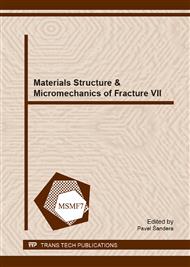p.590
p.594
p.598
p.602
p.606
p.610
p.614
p.618
p.622
Extrapolation of Sigmoidal Creep Curve by Strain Acceleration Parameter
Abstract:
It has been widely accepted that the creep characteristics at high temperatures are mainly evaluated by a minimum creep rate and a time to fracture. Although, a shape of creep curve may vary depending on deformation conditions, the apparent minimum creep rates may become the same value. Thus, for detailed analysis and prediction of creep behavior, other values should be considered which reflects the shape of each creep curve. For the purpose, authors have proposed Satos Strain-Acceleration-Parameter (SAP) which reflects strain rate change during creep. Based on the concept of SAP, the whole creep curve can be represented by a set of small numbers of numerical parameters, and can be extrapolated from a part of creep curve [. It is also well accepted that the creep rates depend on microstructures, and microstructural changes cause strain rate change. The SAP would reflect stability and magnitude of microstructural change during deformation at high temperatures. In this paper, application of the concept of SAP to creep curves that show sigmoidal type primary creep is presented. The creep curve can be divided into two regime based on the SAP values. The sigmoidal creep curve is reasonably reproduced by the concept of Strain-Acceleration-Parameter, and reasonably agrees with experiment. Whole creep curve can be reasonably represented by a few numerical values which reflect shape of creep curve in each regime. The concept of SAP is applicable for quantitative evaluation of both normal and sigmoidal type of creep curves.
Info:
Periodical:
Pages:
606-609
Citation:
Online since:
November 2013
Authors:
Price:
Сopyright:
© 2014 Trans Tech Publications Ltd. All Rights Reserved
Share:
Citation:


